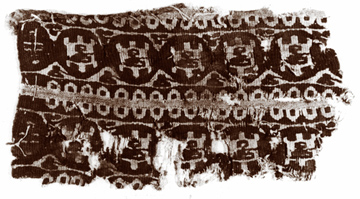
 |
 |
 |
 |
 |
 |
 |
 |
 |
 |
 |
Production
 |
|
Decorated Sleeve
Cuff |
The texts in this section provide evidence for how cloth goods came to be made and acquired. The production of intricately patterned textiles and other high-quality cloth goods required skilled artisans who were trained within a venerable apprenticeship system. In fact, the textile shown here was found with an official apprenticeship contract (see the first text in this section, P. Mich Inv. 5191). That contract and another text in this section, a tax document that mentions a tax on weavers, are strong indications of a well-organized, profitable profession. Another contract records the case of a woman who will weave and carry out other household tasks, not as a professional but as an indentured servant. Hiring a weaver was one way to get cloth goods made in the home. Another option described in some texts in this section was to purchase cloth and raw materials for finishing at home. Several letters in this section tell of items being commissioned from artisans or acquired ready-made. Letters from the correspondence of a man named Apollinarius provide an example of a refined taste for expensive, imported cloth and special attention being paid to color.